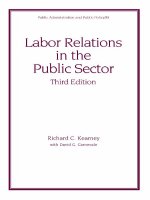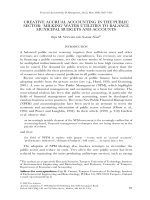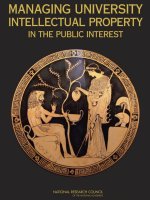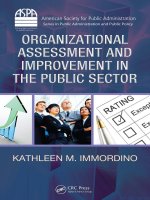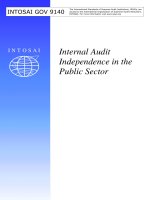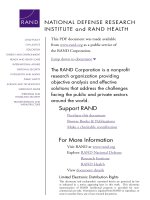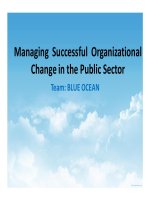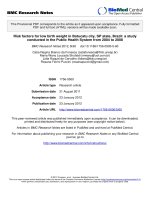Labor Relations in the Public Sector pptx
Bạn đang xem bản rút gọn của tài liệu. Xem và tải ngay bản đầy đủ của tài liệu tại đây (20.9 MB, 403 trang )
Labor Relations
in the
Public Sector
PUBLIC ADMINISTRATION AND PUBLIC POLICY
A Comprehensive Publication Program
Executive Editor
JACK RABIN
Professor of Public Administration and Public Policy
School of Public Affairs
The Capital College
The Pennsylvania State University Harrisburg
Middletown, Pennsylvania
1.
Public Administration as a Developing Disci[91ine (in two parts), Robert
Golembiewski
2. Comparative National Policies on Health Care, Milton I. Roemer, M.D.
3.
Exclusionary Injustice: The Problem of Illegally Obtained Evidence, Steven
R. Schlesinger
4.
Personnel Management in Government: Politics and Process, Jay M.
Shafritz, Walter L. Balk, Albert C. Hyde, and David H. Rosenbloom
5.
Organization Development in Public Administration (in two parts), edited
Robert T. Golembiewski and William B. Eddy
6. Public Administration: A Comparative Perspective, Second Edition, Revised
and Expanded, Ferrel Heady
7. Approaches to Planned Change (in two parts), Robert T. Golembiewski
8. Program Evaluation at HEW (in three parts), edited by James G. Abert
9.
The States and the Metropolis, Patricia S. Florestano and Vincent L.
Marando
10. Personnel Management in Govemment: Politics and Process, Second Edi-
tion, Revised and Expanded, Jay M. Shafritz, Albert C. Hyde, and David H.
Rosenbloom
11. Changing Bureaucracies: Understanding the Organization Before Selecting
the Approach, William A. Medina
12.
Handbook on Public Budgeting and Financial Management, edited by Jack
Rabin and Thomas D. Lynch
13. Encyclopedia of Policy Studies, edited by Stuart S. Nagel
14.
Public Administration and Law: Bench v. Bureau in the United States, David
H. Rosenbloom
15. Handbook on Public Personnel Administration and Labor Relations, edited
by Jack Rabin, Thomas Vocino, W. Bartley Hildreth, and Gerald J. Miller
16. Public Budgeting and Finance: Behavioral, Theoretical, and Technical Per-
spectives, Third Edition, edited by Robert T. Golembiewski and Jack Rabin
17.
Organizational Behavior and Public Management, Debra W. Stewart and G.
David Garson
18. The Politics of Terrorism: Second Edition, Revised and Expanded, edited by
Michael Stohl
19.
Handbook of Organization Management, edited by William B. Eddy
20. Organization Theory and Management, edited by Thomas D. Lynch
21.
Labor Relations in the Public Sector, Richard C. Kearney
22. Politics and Administration: Woodrow Wilson and American Public Ad-
ministration, edited by Jack Rabin and James S. Bowman
23.
Making and Managing Policy: Formulation, Analysis, Evaluation, edited by G.
Ronald Gilbert
24. Public Administration: A Comparative Perspective, Third Edition, Revised,
Ferrel Heady
25. Decision Making in the Public Sector, edited by Lloyd G. Nigro
26. Managing Administration, edited by Jack Rabin, Samuel Humes, and Brian
S. Morgan
27. Public Personnel Update, edited by Michael Cohen and Robert T. Golem-
biewski
28. State and Local Govemment Administration, edited by Jack Rabin and Don
Dodd
29. Public Administration: A Bibliographic Guide to the Literature, Howard E.
McCurdy
30. Personnel Management in Government: Politics and Process, Third Edition,
Revised and Expanded, Jay M. Shafritz, Albert C. Hyde, and David H.
Rosenbloom
31.
Handbook of Information Resource Management, edited by Jack Rabin and
Edward M. Jackowski
32.
Public Administration in Developed Democracies: A Comparative Study,
edited by Donald C. Rowat
33. The Politics of Terrorism: Third Edition, Revised and Expanded, edited by
Michael Stohl
34. Handbook on Human Services Administration, edited by Jack Rabin and
Marcia B. Steinhauer
35.
Handbook of Public Administration, edited by Jack Rabin, W. Bartley
Hildreth, and Gerald J. Miller
36. Ethics for Bureaucrats: An Essay on Law and Values, Second Edition,
Revised and Expanded, John A. Rohr
37. The Guide to the Foundations of Public Administration, Daniel W. Martin
38. Handbook of Strategic Management, edited by Jack Rabin, Gerald J. Miller,
and W. Bartley Hildreth
39. Terrorism and Emergency Management: Policy and Administration, William
L. Waugh, Jr.
40. Organizational Behavior and Public Management." Second Edition, Revised
and Expanded, Michael L. Vasu, Debra W. Stewart, and G. David Garson
41.
Handbook of Comparative and Development Public Administration, edited by
Ali Farazmand
42. Public Administration: A Comparative Perspective, Fourth Edition, Ferrel
Heady
43. Government Financial Management Theory, Gerald J. Miller
44.
Personnel Management in Govemment: Pofitics and Process, Fourth Edition,
Revised and Expanded, Jay M. Shafritz, Norma M. Riccucci, David H.
Rosenbloom, and Albert C. Hyde
45. Public Productivity Handbook, edited by Marc Holzer
46. Handbook of Public Budgeting, edited by Jack Rabin
47. Labor Relations in the Public Sectoc Second Edition, Revised and Ex-
panded, Richard C. Kearney
48. Handbook of Organizational Consultation, edited by Robert T. Golembiewski
49.
Handbook of Court Administration and Management, edited by Steven W.
Hays and Cole Blease Graham, Jr.
50.
Handbook of Comparative Public Budgeting and Financial Management,
edited by Thomas D. Lynch and Lawrence L. Martin
51.
Handbook of Organizational Behavior, edited by Robert T. Golembiewski
52. Handbook of Administrative Ethics, edited by Terry L. Cooper
53.
Encyclopedia of Policy Studies: Second Edition, Revised and Expanded,
edited by Stuart S. Nagel
54. Handbook of Regulation and Administrative Law, edited by David H.
Rosenbloom and Richard D. Schwartz
55.
Handbook of Bureaucracy, edited by Ali Farazmand
56. Handbook of Public Sector Labor Relations, edited by Jack Rabin, Thomas
Vocino, W. Bartley Hildreth, and Gerald J. Miller
57.
Practical Public Management, Robert T. Golembiewski
58. Handbook of Public Personnel Administration, edited by Jack Rabin, Thomas
Vocino, W. Bartley Hildreth, and Gerald J. Miller
59.
Public Administration: A Comparative Perspective, Fifth Edition, Ferrel
Heady
60. Handbook of Debt Management, edited by Gerald J. Miller
61.
Public Administration and Law: Second Edition, David H. Rosenbioom and
Rosemary O’Leary
62. Handbook of Local Govemment Administration, edited by John J. Gargan
63.
Handbook of Administrative Communication, edited by James L. Garnett and
Alexander Kouzmin
64. Public Budgeting and Finance: Fourth Edition, Revised and Expanded,
edited by Robert T. Golembiewski and Jack Rabin
65.
Handbook of Public Administration: Second Edition, edited by Jack Rabin,
W. Bartley Hildreth, and Gerald J. Miller
66. Handbook of Organization Theory and Management: The Philosophical
Approach, edited by Thomas D. Lynch and Todd J. Dicker
67. Handbook of Public Finance, edited by Fred Thompson and Mark T. Green
68.
Organizational Behavior and Public Management: Third Edition, Revised and
Expanded, Michael L. Vasu, Debra W. Stewart, and G. David Garson
69. Handbook of Economic Development, edited by Kuotsai Tom Liou
70.
Handbook of Health Administration and Policy, edited by Anne Osborne Kil-
patrick and James A. Johnson
71. Handbook of Research Methods in Public Administration, edited by Gerald J.
Miller and Marcia L. Whicker
72.
Handbook on Taxation, edited by W. Bartley Hildreth and James A. Richard-
son
73. Handbook of Comparative Public Administration in the Asia-Pacific Basin,
edited by Hoi-kwok Wong and Hon S. Chan
74. Handbook of Global Environmental Policy and Administration, edited by
Dennis L. Soden and Brent S. Steel
75.
Handbook of State Govemment Administration, edited by John J. Gargan
76. Handbook of Global Legal Policy, edited by Stuart S. Nagel
77.
Handbook of Public Information Systems, edited by G. David Garson
78. Handbook of Global Economic Policy, edited by Stuart S. Nagel
79.
Handbook of Strategic Management: Second Edition, Revised and Ex-
panded, edited by Jack Rabin, Gerald J. Miller, and W. Bartley Hildreth
80. Handbook of Global International Policy, edited by Stuart S. Nagel
81.
Handbook of Organizational Consultation: Second Edition, Revised and
Expanded, edited by Robert T. Golembiewski
82. Handbook of Global Political Policy, edited by Stuart S. Nagel
83. Handbook of Global Technology Policy, edited by Stuart S. Nagel
84.
Handbook of Criminal Justice Administration, edited by Toni DuPont-
Morales, Michael K. Hooper, and Judy H. Schmidt
85. Labor Relations in the Public Sector’. Third Edition, edited by Richard C.
Kearney
Additional Volumes in Preparation
Handbook of Global Social Policy, edited by Stuart S. Nagel and Amy Robb
Handbook of Organizational Behavioc Second Edition, Revised and Ex-
panded, edited by Robert T. Golembiewski
Handbook of Administrative Ethics: Second Edition, Revised and Expanded,
edited by Terry L. Cooper
Handbook of Public Quality Management, edited by Ronald J. Stupak and
Peter M. Leitner
Handbook of Crisis and Emergency Management, edited by Ali Farazmand
Handbook of Public Management Practice and Reform, edited by Kuotsai
Tom Liou
Handbook of Comparative and Development Public Administration: Second
Edition, Revised and Expanded, edited by All Farazmand
Principles and Practices of Pubfic Administration [on-line text], edited by Jack
Rabin, Robert Munzenrider, and Sherrie Bartell
Public Administration: A Comparative Perspective, Sixth Edition, Revised
and Expanded, Ferrel Heady
Personnel Management in Govemment: Politics and Process, Fifth Edition,
Jay M. Shafritz, Norma M. Riccucci, David H. Rosenbloom, Katherine C.
Naff, and Albert C. Hyde
ANNALS OF PUBLIC ADMINISTRATION
1. Public Administration: History and Theory in Contemporary Perspective,
edited by Joseph A. Uveges, Jr.
2. Public Administration Education in Transition, edited by Thomas Vocino and
Richard Heimovics
3. Centenary Issues of the Pendleton Act of 1883, edited by David Ho Ro-
senbloom with the assistance of Mark A. Emmert
4.
Intergovemmental Relations in the 1980s, edited by Richard H. Leach
5. Criminal Justice Administration: Linking Practice and Research, edited by
William A. Jones, Jr.
Labor Relations
in the
Public Sector
Third Edition
Richard C. Kearney
East Carolina University
Greenville, North Carolina
with
David G. Carnevale
University of Oklahoma
Norman, Oklahoma
MARCEL
MARCEL DEKKER, INC. NEW YO~,K ¯ BASEL
ISBN: 0-8247-0420.7
This book is printed on acid-free paper.
Headquarters
Marcel Dekker, Inc.
270 Madison Avenue, New York, NY 10016
tel: 212-696-9000; fax: 212-685-4540
Eastern Hemisphere Distribution
Marcel Dekker AG
Hutgasse 4, Postfach 812, CH-4001 Basel, Switzerland
tel: 41-61-261-8482; fax: 41-61-261-8896
World Wide Web
The publisher offers discounts on this book when ordered in bulk quantities. For more
information, write to Special Sales/Professional Marketing at the headquarters address
above.
Copyright © 2001 by Marcel Dekker, Inc. All Rights Reserved.
Neither this book nor any part may be reproduced or transmitted in any form or by any
means, electronic or mechanical, including photocopying, microfilming, and recording,
or by any information storage and retrieval system, without permission in writing from
the publisher.
Current printing (last digit):
1098765432
PRINTED IN THE UNITED STATES OF AMERICA
Preface
Unions seem to be perpetually at a crossroads. Those in the private sector have
suffered membership declines for more than 45 years and, even under the dy-
namic leadership of AFL-CIO President John Sweeney, they will be hard-pressed
to reverse the powerful tide against unions in the private sector. In government,
union membership has been stagnant since the 1980s. Although there have been
some positive incremental changes in the state legal environment for collective
bargaining, no new comprehensive bargaining laws have been enacted since
1992. Meanwhile, fundamental restructuring of private and public organizations
and the processes they use to conduct their business have been occurring at an
ever-increasing rate. Globalization of labor and markets has profoundly chal-
lenged unions in the business sector. For their counterparts in government, contin-
uing citizen resistance to government taxing and spending, joined with the move-
ment to reinvent government, have posed new challenges that provide both threats
and opportunities. In any event, managing in a union environment is a reality
for approximately 40% of public managers, and unions remain key political ac-
tors in the federal government and in a large proportion of state and local jurisdic-
tions.
The third edition of Labor Relations in the Public Sector has been com-
pletely updated in terms of the scholarly and professional literature and relevant
events. Collective bargaining and labor relations are addressed at all levels of
government, with comparisons to the private and nonprofit sectors. The Rein-
venting Government Movement has been incorporated into several chapters. In-
terest-based ("win-win") negotiation is a prominent theme in discussions of the
bargaining process and contract administration. The third edition features several
iii
iv Preface
new case studies that are intended to provide students with experiential learning
exercises.
There have been two changes in the organization of the book. The initial
chapter on the history and development of unions has been separated into two new
chapters: "History and Background" and "The Unions Today." The chapter in
the previous edition on the bargaining process has also been divided into two:
"Fundamentals of the Bargaining Process" and "The Process and Politics of
Public Sector Collective Bargaining." These modifications facilitate inclusion of
new materials and improve the flow and organization of the book.
The third edition is designed to be more classroom-friendly than earlier
versions. As before, the book is intended for use in graduate and undergraduate
courses in labor relations, collective bargaining, human resource management,
and problems in public administration.
Contributing to the book for the first time is David G. Camevale of the
University of Oklahoma. Dr. Carnevale has extensive experience in labor rela-
tions and collective bargaining. His involvement has significantly strengthened
the third edition by lending the insights of a practitioner.
I appreciate the comments and suggestions of professors and students who
have used earlier editions of the book. Thanks also go to Arevik Saribekyan
and Rodney Rose, MPA students at East Carolina University, who helped gather
information and materials for the third edition. A special thanks to Kathy Morgan,
who prepared the index. As always, I am indebted to Kathy and Joel for their
love and support.
Richard C. Kearney
Contents
Preface
1. History and Background
2. The Unions Today
3.
The Legal Environment of Public Sector Labor Relations
4. Fundamentals of the Bargaining Process
5. The Process and Politics of Public Sector Collective Bargaining
6. Financial Impacts of Unions and Collective Bargaining
7. Union Impacts: Personnel Processes and Policies
8. Strike!
9.
Resolving Impasses: Alternatives to the Strike
10.
Living with the Contract
11. Public Employee Unions in the Future
References
Index
iii
1
23
45
81
113
139
177
221
259
293
325
347
379
Labor Relations
in the
Public Sector
1
History and Background
I. INTRODUCTION
As the industrial revolution dawned in England in the mid-eighteenth century, the
employer’s authority was absolute, and completely free from laws or government
regulations. Employers unilaterally determined wages and the terms and condi-
tions of employment for their workers. As a practical matter, all but the most
skilled workers had to take jobs as they came, with little or no opportunity to
influence compensation levels or the nature of the work. Early efforts to form
trade unions were violently suppressed by laws forbidding organization as a crim-
inal conspiracy in restraint of trade.
It was a long hard struggle for employees in England and Europe to gain
the fights to organize and bargain collectively and it took nearly 200 years in
the United States. Today these fights are held in nearly all nations. Labor, in this
sense, is triumphant. But unions in the United States today face new sets of
problems and challenges, the outcomes of which could well determine their very
existence in the next few decades.
The intent of this initial chapter is to discuss the history and development
of unionization and collective bargaining in the private sector and in government.
The roots of government unions are traced through an historical examination of
the American trade union movement. The development of public sector unioniza-
tion is examined, including key factors that contributed to the growth of unions
in government.
A.
Early American Unionism
Labor organizations have existed in the United States since the earliest days of
the Republic. The environment within which they have been created and grown,
however, has not always been friendly or even tolerant.
The earliest domestic roots of American unionism may be traced to the
self-help organizations formed by workers in the crafts and skilled trades prior
to the Revolutionary War. These organizations were, in a sense, transplants of
2 Chapter 1
the European guilds. Probably the first guild to develop in the United States was
the cordwainers (shoemakers) in 1648 in Boston (Commons 1980). This guild
eventually evolved into what some historians believe to be the first American
trade union The Society of Master Cordwainers. The guilds were not true
"unions" in that there was no separation of labor between worker and owner.
Nonetheless, workers were united in a common cause of self-protection.
The early American labor organizations were based on handicraft tech-
nologies like shoe making, stone cutting, carpentry, hat finishing, and printing.
Their membership was composed of skilled laborers organized along the lines
of individual crafts. Today, such organizations are known as craft unions. It is not
surprising that organized labor began with highly skilled, strategically situated
workers, as they were the first to enjoy what is referred to today as bargaining
power.
Public policy toward early labor organizations may be characterized as one
of suppression. They had no legal basis for existence and were considered "crimi-
nal conspiracies in restraint of trade" under common law. This criminal conspir-
acy doctrine emerged from a court case involving the cordwainers, in which a
judge ruled it illegal for Philadelphia shoemakers to act collectively in efforts to
raise their wages. Several of the early craft unions were prosecuted for criminal
conspiracy until the doctrine was ended by the Massachusetts court decision of
Commonwealth v. Hunt (1842), which held that such organized union activities
were lawful.
Some local labor organizations entered the political arena during the 1820s
and 1830s through affiliating with "workingmen’s parties." They pressed
Congress and state legislatures for job-related concessions such as the 10-hour
day, and also for broader reforms such as free universal education, an end to the
military draft, abolition of debtor’s prisons, and expansion of suffrage. Many
of these organizations, which were strongest in large cities such as New York
and Philadelphia, even took a short-lived step towards national organization
in 1834 by forming the National Trades Union to coordinate activities of the
locals.
It was during this same time period (1820s to 1830s) that labor organiza-
tions began to penetrate public employment, as public workers in skilled occupa-
tions sought the 10-hour day won in some cities by their private counterparts.
Most of this activity was concentrated in federal naval shipyards in Philadelphia,
Boston, and New York. Later, when agitation for the 8-hour work day began,
the first employer to grant it was the federal government, at the Charleston, South
Carolina, Navy Yard in 1842. According to Spero (1948:87), the drive for the
8-hour day "led to the crystallization of the principle of the state as a model
employer maintaining the highest possible working standards in its services as
an example for others to follow."
History and Background
3
During this early period of growth and development, unions’ organizational
health was highly dependent on national economic conditions; unions suffered
during hard times and revived during more prosperous times. For example, there
was a tremendous increase in union membership during the Civil War and imme-
diately afterward as a consequence of industrial growth related to the war effort.
The Depression of 1873, however, was accompanied by a startling decline in
national union membership from 300,000 to 50,600 within five years. By 1885,
improved economic conditions pushed membership growth back to the 300,000
mark. The direct relationship between economic tailspins and union membership
declines did not endure during the 20th Century. Unions suffered during the pros-
perous 1920s, and made their most spectacular gains during the Great Depression
era of the 1930s.
Nonetheless, economic conditions continue to influence union fortunes to-
day. For instance, when unemployment is low and consumer demand for products
is high, employers tend to accommodate employee demands, even the demand
for unions. Concurrently, risk-taking union advocates find it relatively easy to
locate new jobs if they are fired. Thus, unionism is likely to flourish during favor-
able economic conditions. The opposite argument applies for periods of high
unemployment and a weak economy (Reder 1988:92-93). In both situations,
course, many other factors also influence union growth. In the past three decades,
private sector unions have struggled with membership losses during good eco-
nomic times and bad.
Even though labor organizations could no longer be legally prosecuted for
criminal conspiracy in restraint of trade after the 1842 Commonwealth v. Hunt
decision, this did not by any means signal a new era of tolerance and encourage-
ment of unionism. Bitter union-management battles erupted during the 1870s.
Employer "union-busting" tactics such as lockouts, espionage, blacklisting of
union organizers, summary firings of "agitators," and, in order to break strikes,
club-swinging "goon squads," forced some unions to go underground and oper-
ate as secret societies. One of these societies the Molly Maguires, formed by
anthracite coal miners met employer violence with violence of its own in perpe-
trating acts of arson and murder in the Pennsylvania coal mines.
Many opposing union philosophies competed for the allegiance of the
American working class during the late 1800s and early 1900s. Some groups
sought victories through the political process while others advocated collective
bargaining. Most organizations wanted to operate and pursue their goals within
the boundaries of the capitalist system, but others spoke out in favor of the emerg-
ing European philosophies of socialism and communism.
Perhaps the strongest of the leftist groups was the Industrial Workers of
the World (IWW), which rejected capitalism outright and strove to organize the
working class, take control of the State, and overturn the capitalist system.
4 Chapter 1
Founded in 1905 by radical socialists and syndicalists, whose penchant for a good
fight took precedence over "planning, negotiating, and politiking [sic]" (Stegner
1990:13), the "Wobblies" enjoyed their greatest strength among mining, lumber-
ing, and agricultural workers in the western states of Idaho, Colorado, and Utah.
(The nickname reportedly was taken from a Chinese cook’s pronunciation of
IWW as "I wobble wobble"). The Wobblies committed numerous acts of indus-
trial sabotage and were successful in leading several large strikes in the United
States and other countries during the First World War. Many martyrs were pro-
duced along the way, including the legendary Joe Hill, who, just before his exe-
cution in 1915, cried to his fellow Wobblies, "Don’t waste time mourning, or-
ganize!" But severe repression by the federal government including the
incarceration and lynching of union leaders such as Joe Hill and the lack of
broad appeal of IWW philosophies to the American working class, led to the
demise of the organization shortly after the War (see Galenson 1980 for conven-
tional treatment). The Wobblies’ utopian vision of "one big union" for the work-
ers of the world remains an historical curiosity to all except a handful of diehards
who in the late 1980s sought to revive the IWW through the international peace
movement (for current information on this unique organization, see the IWW
website at: www.IWW.org).
Other labor organizations on the ideological far left have enjoyed some
support in the United States, including the Farm Equipment Workers, Tobacco
and Allied Workers, United Office and Professional Workers, and the Fisher-
man’s Union. Two communist unions even managed to survive the McCarthy-era
repression of the 1950s: the International Longshoremen’s and Warehousemen’s
Union and the United Electrical, Radio, and Machine Workers. But a number
of factors have conspired to mitigate socialist- and communist-oriented labor
organizations in the United States. The rigid class structures of Europe have never
developed in the United States to set the boundaries for class conflict, largely
because of the rapid economic growth of the country, a relatively high standard
of living for the working people, fairly steady economic growth with the opportu-
nity for individual advancement, and the diverse ethnic and religious characteris-
tics of American immigrants. From a political perspective, organized labor has
been hemmed in by the absence of a labor-based political party and by actions
of federal and state courts that have constricted the boundaries of union political
and organizing activities (Galenson 1980:73-79; Forbath 1991).
The real battles within the labor movement in the United States have not
been fought over questions of political ideology, but over the issues of which
types of workers should be organized and by whom. The ethos of business union-
ism, as originally professed by Samuel Gompers, has dominated the American
labor movement throughout this century. Economic objectives and improvements
in working conditions have served as the primary objectives of trade unionism,
History and Background 5
not social and political change. Theories of the labor movement in the United
States reflect the early ascendancy of business unionism, asserting that American
workers have joined unions for job security (Tannenbaum 1921), out of a concern
for the scarcity of job opportunities (Perlman 1928), as a means for democratizing
the workplace (Webb and Webb 1897), as a result of expansion of the job market
from increased industrialization (Commons and Associates 1936), from a crystal-
lization of group interests arising from workers’ social and economic situations
(Hoxie 1928), and in response to various monetary and fringe benefits incentives
(Olson 1965). The Marxist philosophy that unions form the locus of a working
class consciousness and serve as the basis for restricting competition over jobs
has never been widely accepted in the United States.
As already noted, the earliest organizing efforts were among the craft
unions. Heavy industrialization, which began during the mid-1800s, provided a
new and rapidly growing industrial labor force of nonskilled and semiskilled
workers who were not trade or craft oriented. Organization of this new pool of
workers would have to be along shop lines, based on the place of work rather
than on the type of work. The Knights of Labor made the first significant effort
to capture this segment of the work force.
Formed in 1869 as a craft union for custom tailors in Philadelphia, the
Knights gradually began to include other crafts under its organizational umbrella.
By 1878 it had evolved into the first national labor union in the United States.
The following year the Knights dropped its status as a secret society, and under
the leadership of an affable Irishman named Terence V. Powderly, began to seek
both craft and industrial affiliates throughout the country. By the time of its suc-
cessful 1886 strike against financier Jay Gould and the Wabash Railroad, the
Knights claimed a membership of 700,000. The Knights’ membership was some-
what unstable and divisive, however, and a subsequent series of ill-conceived
strikes led to one defeat after another for the union. By the turn of the century
the Knights of Labor was nearly extinct. Further organization of unskilled work-
ers awaited the development of the Congress of Industrial Organizations in the
1930s.
The remaining craft union pieces of the complex Knights of Labor organi-
zational mosaic were quickly gathered up by the American Federation of Labor
(AFL), which was originally formed in 1881 in Pittsburgh as a federation for
skilled craft workers. The 25 national craft union affiliates elected Samuel Gom-
pers, head of the Cigar Makers Union, as their first president. The ultimate prag-
matist, Gompers soon made the AFL a major actor in the American economic
system. Gompers was, in essence, a free marketeer who rejected philosophical,
political, and social issues in favor of an almost laissez-faire labor environment.
Under his leadership the AFL grew steadily, surviving both the depression of
1893 to 1896 and a violent strike that broke the back of one of the AFL locals
6 Chapter 1
at the Carnegie Steel Company in Homestead, Pennsylvania. The AFL also
proved strong enough to withstand the scientific management movement of Fred-
erick W. Taylor, court injunctions against strikes and other union actions, and
years of stifling "yellow-dog contracts" (a contract in which a worker promised
not to join a union while under the hire of an employer). There were, however,
some dark times, particularly following World War I and during the early years
of the Great Depression.
The AFL’s resurgence after the Great Depression was, in the words of
Sloane and Witney (1981:75-76), "in spite of itself," as the union "almost
snatched defeat from the jaws of victory." A leadership gap was part of the
problem (Gompers had died), but more to blame was the union’s continuing
reactionary posture against mass production workers whom the Knights of Labor
had first tried to organize. The AFL’s unrelenting refusal to allow nonskilled,
noncraft workers into the organization eventually prompted a secessionist move-
ment steered by John L. Lewis of the United Mine Workers, after his efforts to
gain affiliation for industrial workers failed at the 1935 AFL convention in Atlan-
tic City. Lewis did not exit that convention meekly. According to Sloane and
Witney (1981:77), "Lewis, never one to camouflage his emotions for the sake
of good fellowship with his AFL colleagues, left Atlantic City only after landing
a severe uppercut to the jaw of Carpenter Union president William L. Hutche-
son " Lewis then formed his own industrial union, the Committee for Indus-
trial Organization, later called the Congress of Industrial Organizations (CIO).
There followed another, later attempt to affiliate under the AFL banner, but it
culminated in the expulsion of CIO leaders and the more than 30 national unions
that had joined forces with the CIO.
The independent CIO was highly successful in organizing industrial work-
ers, such as those in the automobile and steel industries, so much so that the AFL
finally recognized the error of its ways and itself began competing for unskilled
workers. Not to be outdone, the CIO turned its own efforts to the organization
of craft workers. In 1955, after years of interunion conflict and competition, the
AFL merged permanently with the CIO, becoming "the united house of labor."
The labor battles had been fought not over political ideology or competing
grand visions of American society, but over organizing workers and the mundane
bread-and-butter issues that today remain paramount: wages, fringe benefits,
working conditions, and job security. To George Meany, as well as to the other
mainstream labor leaders, ideology was "baloney" (Sloane and Witney 1981:
94). Unions became active in the political arena during the 1960s and remain so
today, pressing a broad national agenda for social betterment with varying de-
grees of success (see Boyle 1998). However, no coherent ideology is apparent.
Ironically, the year following the AFL-CIO merger marked the beginning
of a long and continuous decline in union organization in private employment.
History and Background
7
In 1956, the first year in which the total number of U.S. white-collar employees
exceeded the number of blue-collar workers, one-third of the nation’ s nonagricul-
tural workers were unionized. By 1999, only one in seven were members just
13.9 percent of the total work force, and only 9.5 percent of private sector work-
ers. The absolute number of private sector union members continued to rise until
1970, but has since declined to 9.5 million (U.S. Bureau of Labor Statistics 2000).
Table 1.1 shows membership figures for the largest private sector unions today.
Table 1.2 displays public and private sector union membership by state.
B. Factors Contributing to Private-Sector Union Decline
The fading fortunes of unions in the private sector have spawned a great amount
of discussion and debate. Three major factors have contributed to union decline,
although their relative importance is subject to dispute (e.g., Freeman and Medoff
1984; Goldfield 1987; Kochan et at. 1986).
1. Structural Elements
These are associated with broad social and economic changes that have affected
the composition of the work force, the general nature of employment, the shift
of jobs from the heavily organized Northeast and Midwest to the predominantly
nonunion South and Southwest, and the demographic characteristics of the work
force. More specifically, the labor force has become increasingly female, minor-
ity, and part-time, with correspondingly different needs than the mostly white
male workers of the past. It is also increasingly white collar, as employment has
TABLE 1.1 Membership in Largest Private Sector Unions
Union
Membership (Year)
International Brotherhood of Teamsters
1,500,000 (2000)
Service Employees International Union
375,0001 (1999)
United Food and Commercial Workers
1,400,000 (2000)
United Auto Workers
770,000 (1999)
International Brotherhood of Electrical Workers
679,000 (1995)
International Association of Machinists
475,000 (2000)
Laborers International Union
425,000 (1998)
UNITE
276,000 (1998)
United Steel Workers
700,000 (1999)
Source: Self-reported figures from each organization’s Internet website.
1Does not include public and nonprofit sector membership.
8
TABLE 1.2 Union Membership for 1997
Chapter 1
ALL WAGE AND SALARY WORKERS, PUBLIC AND PRIVATE
Union members Percent members
State 1997 1997
All States 16,109,900 14.1
Alabama 184,500 10.2
Alaska 50,100 20.0
Arizona 131,700 7.0
Arkansas 59,400 5.9
California 2,066,700 16.0
Colorado 174,200 9.6
Connecticut
247,800
16.9
Delaware 39,200 11.7
Florida 403,000 6.8
Georgia 238,100 7.1
Hawaii 126,700 26.3
Idaho 43,400 8.5
Illinois 970,800 18.5
Indiana 398,600
14.6
Iowa
172,400
13.2
Kansas 86,900 7.8
Kentucky 193,100 12.2
Louisiana 118,700 7.0
Maine 72,000 13.5
Maryland 348,700 14.9
Massachusetts 423,100 15.1
Michigan 969,000 23.1
Minnesota 436,100 19.9
Mississippi 57,500 5.4
Missouri 359,300 14.6
Montana 47,300 13.8
Nebraska 68,800 9.3
Nevada 147,100 19.1
New Hampshire 55,600 10.2
New Jersey 802,100 22.0
New Mexico 55,600
8.4
New York 1,949,400
26.3
North Carolina
126,200
3.8
North Dakota 23,900 8.6
Ohio 931,300 18.9
Oklahoma 109,500 8.4
Oregon 242,200 17.6
Pennsylvania
866,000 17.1
History and Background
TABLE 1.2 Continued
ALL WAGE AND SALARY WORKERS, PUBLIC AND PRIVATE
Union members
Percent members
State 1997
1997
Rhode Island 80,900 18.7
South Carolina 61,300 3.7
South Dakota 21,000 6.9
Tennessee 192,900 8.6
Texas 538,600 6.4
Utah 74,000 8.3
Vermont 21,800 8.5
Virginia 192,600 6.5
Washington 508,200 20.5
West Virginia 105,600 15.6
Wisconsin 468,000
18.8
Wyoming 18,700 9.3
Source: Compiled from the Current Population Survey 1998.
shifted from manufacturing, mining, construction, and transportation to services
such as banking and finance, insurance, and information-based technology. His-
torically, white-collar workers have been difficult to organize because of the pres-
tige and professionalism associated with their jobs, special interests and needs
that have not been attended to by the unions, and the generally poor image of
organized labor among this group (Sloane and Whitney 1981:10-13). In a sense,
unions have also been victims of their own success. Union-ratcheted salaries
and wages placed firms in Pennsylvania, Illinois, Michigan, and New York at a
competitive disadvantage, encouraging many of them to move to low-wage non-
union states such as Texas, Tennessee, and North Carolina, and, increasingly, to
developing countries.
The structural explanation seems compelling on the surface, but empirical
investigations have determined that its contribution to union decline is moderate.
Furthermore, similar structural changes have been occurring in Canada, the
United Kingdom, Germany, and other industrialized nations where unionization
remains relatively healthy and is even growing.
2.
Unfavorable Legal and Policy Environment
It is asserted that the decline of unions can be attributed at least partly to restric-
tions on labor organizing and other activities by the Taft-Hartley, Landrum-
Griffin, and other legislation. For example, Taft-Hartley prohibits the require-
10 Chapter 1
ment of union membership as a condition of employment (the "closed shop")
and permits "fight-to-work" laws (which bar the "union shop"). Taft-Hartley
also restricts slowdowns, sit-down strikes, and wildcat strikes. Moreover, the
National Labor Relations Board (NLRB), which administers federal labor law
and investigates and decides allegations of unfair labor practices against employ-
ers and unions, has delivered a high proportion of unfavorable decisions to unions
in the last two decades (Gross 1995; Forbath 1991). The federal courts have been
criticized for anti-union decisions as well. For example, the so-called MacKay
Doctrine, promulgated by the U.S. Supreme Court in 1938 but not widely applied
until President Ronald Reagan emboldened business by sacking 11,000 air traffic
controllers in 1981, allows firms to hire permanent replacements for striking
workers. These concerns have led union supporters to call for congressional ac-
tions to level a labor-management playing field that appears to be tilting against
the unions. Yet Congress has been influenced by business interests who have
frequently succeeded in rallying Republicans and conservative Democrats to de-
feat labor-friendly legislation. For instance, a bill to ban permanent replacement
of striking employees passed the House by a wide margin in 1992, but business
interests helped bottle it up in the Senate.
3. Strategic Factors
The strategic choices made and not made by union leaders have contributed
to union decline. Some critical choices made decades ago, including the rejection
of ideological approaches to labor’s relationship to government and the failure
to mount a labor party to compete for a legitimate voice in government, debilitate
labor’s political power and influence today. Labor’s long-term reliance on the
Democratic Party for political clout continues today (Dark 1999). But to many
Democrats, labor is just another interest group.
From the 1970s until 1998, unions spent less money on organizing new
members and participated in fewer NLRB certification elections than in earlier
years (the trend was reversed in 1998 with AFL-CIO President John Sweeney’s
organizing initiatives). What’s more, management won far more union elections
than they lost. Employer resistance to unions has grown dramatically, assisted
by hundreds of management consulting firms specializing in "union-busting"
(Bernstein 1985; Gagala 1983: Ch. 3). Various tactics bolster employer resistance
to unions. "Positive employee relations" means establishing a compensation sys-
tem and working conditions that are as good as or better than those found in
unionized workplaces. Other legal resistance techniques involve hiring consul-
tants to help contest union elections through tough, well-financed corporate cam-
paigns to keep the unions out; stirring worker doubts about the potential benefits
of unions; delaying certification elections until a majority of employees have lost
interest in joining a union; and refusing to bargain collectively even if a union
is established. Finally, employers can instigate actions to decertify a union. This
History and Background 11
tactic was quite successful in the 1980s, with the total number of union decertifi-
cations nearly doubling (Levine 1989).
Some firms also engage in illegal activities to fight unions. Workers are
threatened, union organizers are fired, and lies and distortions are disseminated.
Such employer opposition is asserted by some scholars to be the leading "cause
of the slow strangulation of private sector unionism" (Freeman and Medoff 1984:
239; see also Goldfield 1987). The reasons for management intransigence are not
difficult to fathom. Keeping unions out means higher profits for the firm. It also
means that certain managers keep their jobs; those perceived to be responsible
for losing a union election may find themselves quickly on the street (Freeman
and Kleiner 1990:363)!
Merely to survive, unions must continually recruit new members. Orga-
nized labor has not told a compelling story of why today’s workers should want
to join a union, nor has it manufactured the positive public image and support
necessary to nurture a receptive audience of unorganized workers.
Ultimately, the responsibility for strategic errors by unions must be laid at
the feet of unimaginative, reactive, and all too often self-interested and cor-
rupt union leaders. Labor has too often poisoned its own well by betraying its
members through fraud and corruption and by forming indefensible alliances with
organized crime (Fraser 1998).
Can the private sector union decline be reversed, or is it an inevitable part
of a postindustrial society? Where is the bottom? The hemorrhaging has been
going on for over 40 years and shows limited signs of arrest. However, unions
suffered earlier periods of decline (Rachlett 1999). For instance, unions lost al-
most 40 percent of their membership from 1920 to 1933, then recovered strongly.
Another such reversal is possible, but it presupposes more astute union leader-
ship, more effective organizing strategies, effective coalition-building strategies
with other powerful interest groups, a shift in employer and public opinion in
favor of unions, and a more facilitative legal environment, among other factors
(see Tillman and Cummings 1999).
Some cause for optimism arose in 1995, when former SEIU president John
J. Sweeney was elected president of the 13-million member AFL-CIO (Dark
1999:178-184). Sweeney, whose SEIU membership had doubled even as most
other AFL-CIO affiliates’ ranks thinned, worked hard to reverse labors’ declining
fortunes and provoked a far-reaching reexamination of labor’s role in the 21st
Century. Sweeney took steps to include more women and minorities in union
leadership positions, dedicated millions of new dollars to organizing drives, and
greatly elevated labor’s profile during the presidential election of 1996 and the
congressional elections of 1998.
Will such actions be sufficient to stimulate a rebirth of labor in the U.S.
private sector? It is too soon to know. For every action taken to rejuvenate the
unions, business interests and their Republican allies have countered with efforts
12 Chapter 1
to rewrite labor laws and other strategies designed to disadvantage unions, such
as restrictions on using members’ dues for political and lobbying expenses.
Even the celebration following the tactically clever and surprisingly suc-
cessful Teamster strike against United Postal Service (UPS) in 1997 proved
be short lived. Initially, it appeared that the strike would represent a turning point
for the unions, which had garnered widespread public sympathy for UPS drivers
and mail handlers by portraying their job action as an attack on big business and
the "new economy" of insecure part-time workers. Public opinion sided with
the union by a 2 to 1 margin, boosted, no doubt, by positive feelings towards
UPS drivers and their packages (Schneider 1988). With the strong support
other AFL-CIO affiliates, the Teamsters won the strike by forcing UPS to convert
10,000 part-time positions to full time and to abandon a plan for the company
to assume control of the employees’ pension fund.
Just as the resuscitation of the sickly patient was being widely heralded,
labor once again suffered an untimely relapse as yet another Teamster scandal
this one highly contagious infected the top leadership of several other AFL-
CIO unions. Seventy Teamster locals had been placed under trusteeship by the
federal government because of corruption and links to organized crime. Reform
president Ron Carey had expelled hundreds of local officials. Finally it seemed
that the ethically challenged union had cleaned itself up. But federal officials
overturned Carey’s narrow reelection victory over James P. Hoffa, Jr. because
of an illegal money-laundering scheme. Carey’s campaign manager and two con-
sultants pleaded guilty to related charges. Improper conduct by AFL-CIO Secre-
tary Treasurer Richard Tmmka and American Federation of State, County, and
Municipal Employees President Gerald McEntee was also cited. A new election
was ordered with Carey forbidden to ran. Hoffa was then elected president. The
tragedy for labor was that despite sincere efforts to get its own house in order,
little had really changed in the eyes of the media and the public. "New Labor’ s"
desire to reinvent, reinvigorate, and reposition itself under Sweeney’s leadership
faced significant obstacles from congressional Republicans, national conservative
groups, business interests, and a skeptical public.
C.
Unions in GovernmentmThe Early Years
As noted above, public employee organizations first became active during the
early 1800s, particularly in federal shipyards. However, until 1836 even in the
shipyards they experienced limited success, as military bosses tended to be rather
insensitive to the opinions of their workers. In that year a Washington, D.C. naval
shipyard strike and a mass demonstration led to intervention by President Andrew
Jackson, who personally granted the federal employees the 10-hour day they
sought. A tradition of direct presidential involvement in federal labor problems
was to continue even after passage of the 1978 Civil Service Reform Act.
